Linkages between the Promotion of Renewable Energy Policies and Low-Carbon Transition Trends in South America’s Electricity Sector
Abstract
:1. Introduction
2. Materials and Methods
- Data collection of electricity generation by source (GWh), the historical background of the government actions (laws, plans, decrees, and auctions) focusing on renewable sources, and the lifecycle of GHG emissions (including infrastructure and supply chain emissions, biogenic CO2 emissions and albedo effect methane emissions) of the electricity supply technologies (gCO2eq/kWh).
- Calculation of renewable/non-renewable ratio to assess the low-carbon transition shifts for the five South American countries.
- Figure 1 summarizes the methodological procedures of this work.
3. Results
3.1. Argentina
3.2. Brazil
3.3. Chile
3.4. Uruguay
3.5. Venezuela
4. Discussion
- -
- Argentina and Brazil showed opposite trends in terms of consumption growth rate and ratio; that is, with the increase in consumption, there is a tendency for fossil fuels to increase. This correlation can be proven according to Table 7. It is noteworthy that natural gas, whether through national reserves or imports, contributed to this reverse low-carbon transition trend in both countries. However, there has been a more significant influx of non-conventional renewable sources in both countries in recent years through public policies instituted in the country.
- -
- Chile and Venezuela showed an increase in consumption (except in the recent years in Venezuela), at a ratio that remained in the same range during the years analyzed.
- -
- Uruguay, differently from other countries, presented a growth rate of renewables higher than the consumption of electricity.
5. Conclusions
- There is a general trend of low-carbon reverse transition with increased CO2eq emissions, mainly related to a growing share of natural gas in the electricity sector (e.g., Argentina and Brazil), boosted by consecutive water crises in recent decades.
- All the countries studied show a time trend of increasing renewables in the electricity sector. However, the emission reduction effect resulting from this effort does not occur at the same intensity. It is necessary to better link cause and effect.
- Even though the countries presented promising similarities (e.g., auctions), each country brought forward its dynamics of response to the introduction of renewables.
- Historical context and natural resource availability are decisive aspects for a low-carbon energy transition to take place.
- Argentina, Brazil, Chile (in recent years), and Uruguay showed an increase in the share of renewables in the matrix associated with decreased emissions of GHG. In Venezuela, there is a reduction in emissions disassociated with the insertion of renewables, which is linked to the decrease in electricity generation.
- The difference in the intensity between the entry of renewables and the decrease in emissions seen in the countries is associated with the different political choices, availability of natural resources, technology, and historical context.
- It is also observed that some countries have already gone through energy transitions from fossil fuels to renewable ones in the past (e.g., Brazil). In addition, some of them already have their electricity mixed with a higher percentage of renewables (e.g., Uruguay and Brazil). However, it should be noted that some case studies are adding (renewable) energy rather than replacing fossil fuels. This fact is mainly due to energy security issues and increased consumption. However, it is extremely relevant to recognize the domestic energy transition of each country and the opportunities to promote alternative sources for electricity generation.
Author Contributions
Funding
Institutional Review Board Statement
Informed Consent Statement
Data Availability Statement
Acknowledgments
Conflicts of Interest
References
- IEA. Net Zero by 2050; IEA: Paris, France, 2021. [Google Scholar]
- IRENA. World Energy Transitions Outlook: 1.5 °C Pathway; IRENA: Abu Dhabi, United Arab Emirates, 2021. [Google Scholar]
- Hydrogen Council. Path to Hydrogen Competitiveness—A Cost Perspective; Hydrogen Council: Brussels, Belgium, 2020. [Google Scholar]
- Arent, D.J.; Wise, A.; Gelman, R. The status and prospects of renewable energy for combating global warming. Energy Econ. 2011, 33, 584–593. [Google Scholar] [CrossRef]
- Gielen, D.; Boshell, F.; Saygin, D.; Bazilian, M.D.; Wagner, N.; Gorini, R. The role of renewable energy in the global energy transformation. Energy Strategy Rev. 2019, 24, 38–50. [Google Scholar] [CrossRef]
- York, R.; Bell, S.E. Energy Transitions or Additions: Why a Transition from Fossil Fuels Requires More than the Growth of Renewable Energy. Energy Res. Soc. Sci. 2019, 51, 40–43. [Google Scholar] [CrossRef]
- IRENA. Global Energy Transformation: A Roadmap to 2050; IRENA: Abu Dhabi, United Arab Emirates, 2018. [Google Scholar]
- Macedo, S.F.; Peyerl, D. Prospects and economic feasibility analysis of wind and solar photovoltaic hybrid systems for hydrogen production and storage: A case study of the Brazilian electric power sector. Int. J. Hydrogen Energy 2022, 47, 10460–10473. [Google Scholar] [CrossRef]
- Archibugi, D.; Pietrobelli, C. The globalisation of technology and its implications for developing countries: Windows of opportunity or further burden? Technol. Forecast. Soc. Chang. 2003, 70, 861–883. [Google Scholar] [CrossRef]
- Bridge, G.; Bouzarovski, S.; Bradshaw, M.; Eyre, N. Geographies of energy transition: Space, place and the low-carbon economy. Energy Policy 2013, 53, 331–340. [Google Scholar] [CrossRef]
- Li, L.; Taeihagh, A. An in-depth analysis of the evolution of the policy mix for the sustainable energy transition in China from 1981 to 2020. Appl. Energy 2020, 263, 114611. [Google Scholar] [CrossRef]
- Cai, W.; Wang, C.; Wang, K.; Zhang, Y.; Chen, J. Scenario Analysis on CO2 Emissions Reduction Potential in China’s Electricity Sector. Energy Policy 2007, 35, 6445–6456. [Google Scholar] [CrossRef]
- Gerbelová, H.; Amorim, F.; Pina, A.; Melo, M.; Ioakimidis, C.; Ferrão, P. Potential of CO2 (Carbon Dioxide) Taxes as a Policy Measure towards Low-Carbon Portuguese Electricity Sector by 2050. Energy 2014, 69, 113–119. [Google Scholar] [CrossRef]
- Bushnell, J.; Chen, Y.; Zaragoza-Watkins, M. Downstream Regulation of CO2 Emissions in California’s Electricity Sector. Energy Policy 2014, 64, 313–323. [Google Scholar] [CrossRef]
- Parthan, B.; Osterkorn, M.; Kennedy, M.; Hoskyns, S.J.; Bazilian, M.; Monga, P. Lessons for Low-Carbon Lessons for Low-Carbon Energy Transition: Experience from the Renewable Energy and Energy Efficiency Partnership (REEEP). Energy Sustain. Dev. 2010, 14, 83–93. [Google Scholar] [CrossRef]
- Relva, S.G.; da Silva, V.O.; Gimenes, A.L.V.; Udaeta, M.E.M.; Ashworth, P.; Peyerl, D. Enhancing developing countries’ transition to a low-carbon electricity sector. Energy 2020, 220, 119659. [Google Scholar] [CrossRef]
- Fuentes, S.; Villafafila-Robles, R.; Rull-Duran, J.; Galceran-Arellano, S. Composed Index for the Evaluation of Energy Security in Power Systems within the Frame of Energy Transitions—The Case of Latin America and the Caribbean. Energies 2021, 14, 2467. [Google Scholar] [CrossRef]
- Pye, S.; Bataille, C. Improving deep decarbonization modelling capacity for developed and developing country contexts. Clim. Policy 2016, 16, S27–S46. [Google Scholar] [CrossRef]
- Urban, F.; Benders, R.M.J.; Moll, H.C. Modelling Energy Systems for Developing Countries. Energy Policy 2007, 35, 3473–3482. [Google Scholar] [CrossRef]
- D’Espada, A.L.R. Regulatory Aspects of Energy Efficiency in Uruguay. In The Regulation and Policy of Latin American Energy Transitions; Guimarães, L.N., Ed.; Elsevier: Amsterdam, The Netherlands, 2020; pp. 173–191. [Google Scholar]
- Moretto, E.M.; Gomes, C.S.; Roquetti, D.R.; Jordão, C.D.O. Histórico, tendências e perspectivas no planejamento espacial de usinas hidrelétricas brasileiras: A antiga e atual fronteira Amazônica. Ambient. Soc. 2012, 15, 141–164. [Google Scholar] [CrossRef]
- Hunt, J.D.; Stilpen, D.; de Freitas, M.A.V. A review of the causes, impacts and solutions for electricity supply crises in Brazil. Renew. Sustain. Energy Rev. 2018, 88, 208–222. [Google Scholar] [CrossRef]
- Istepanian, H.H. Iraq’s Electricity Crisis. Electr. J. 2014, 27, 51–69. [Google Scholar] [CrossRef]
- Valasai, G.D.; Uqaili, M.A.; Memon, H.R.; Samoo, S.R.; Mirjat, N.H.; Harijan, K. Overcoming electricity crisis in Pakistan: A review of sustainable electricity options. Renew. Sustain. Energy Rev. 2017, 72, 734–745. [Google Scholar] [CrossRef]
- de Souza, E.S.; Freire, F.D.S.; Pires, J. Determinants of CO2 emissions in the MERCOSUR: The role of economic growth, and renewable and non-renewable energy. Environ. Sci. Pollut. Res. 2018, 25, 20769–20781. [Google Scholar] [CrossRef]
- Washburn, C.; Pablo-Romero, M. Measures to Promote Renewable Energies for Electricity Generation in Latin American Countrie. Energy Policy 2019, 128, 212–222. [Google Scholar] [CrossRef]
- Arango-Aramburo, S.; Ríos-Ocampo, J.P.; Larsen, E.R. Examining the Decreasing Share of Renewable Energy amid Growing Thermal Capacity: The Case of South America. Renew. Sustain. Energy Rev. 2020, 119, 109648. [Google Scholar] [CrossRef]
- Vargas, A.; Saavedra, O.R.; Samper, M.E.; Rivera, S.; Rodriguez, R. Latin American Energy Markets: Investment Opportunities in Nonconventional Renewables. IEEE Power Energy Mag. 2016, 14, 38–47. [Google Scholar] [CrossRef]
- Bersalli, G.; Pereira, A.; Feres, J. Naturaleza En Movimiento: Políticas de Promoción Para Las Nuevas Energías Renovables. Integr. Comer. 2015, 19, 213–225. [Google Scholar]
- Zabaloy, M.F.; Guzowaki, C. Energy Transition Policy from Fossil Fuels to Renewable Energy: The Case of Argentina, Brazil and Uruguay in 1970–2016 Period. Rev. Coyunt. Perspect. 2018, 38, 2–34. [Google Scholar]
- Dinato, R.M.; Silva, V.O.D.; Gimenes, A.L.V.; Udaeta, M.E.M.; Grimoni, J.A.B. Environmental issues related to electricity exchange between South American Countries. In Proceedings of the 23 World Energy Council, Istanbul, Turkey, 9–13 October 2016. [Google Scholar]
- World Bank GDP per Capita (Current US$). Available online: https://data.worldbank.org/indicator/NY.GDP.PCAP.CD (accessed on 15 February 2020).
- IEA. IEA Atlas of Energy; IEA: Paris, France, 2020. [Google Scholar]
- Suehiro, S. Energy Intensity of GDP as Index of Energy Conservation: Problems in International Comparison of Energy Intensity of GDP and Estimate Using Sector-Based Approach; Institute of Energy Economics–IEEJ: Tokyo, Japan, 2007. [Google Scholar]
- Antonakakis, N.; Chatziantoniou, I.; Filis, G. Energy Consumption, CO2 Emissions, and Economic Growth: An Ethical Dilemma. Renew. Sustain. Energy Rev. 2017, 68, 808–824. [Google Scholar] [CrossRef]
- Ito, K. CO2 Emissions, Renewable and Non-Renewable Energy Consumption, and Economic Growth: Evidence from Panel Data for Developing Countries. Int. Econ. 2017, 151, 1–6. [Google Scholar] [CrossRef]
- IAEA. Energy Indicators for Sustainable Development: Guidelines and Methodologies; IAEA: Vienna, Austria, 2005. [Google Scholar]
- IEA. Electricity Generation by Souce. Available online: https://www.iea.org/data-and-statistics/charts/electricity-generation-b (accessed on 23 November 2021).
- WNA. Comparison of Lifecycle Greenhouse Gas Emissions of Various Electricity Generation Sources; WNA: London, UK, 2011. [Google Scholar]
- IPCC. Guidelines for National Greenhouse Gas Inventories; IGES: Hayama, Japan, 2006. [Google Scholar]
- Nagayama, H.; Kashiwagi, T. Evaluating Electricity Sector Reforms in Argentina: Lessons for Developing Countries? J. Clean. Prod. 2007, 15, 115–130. [Google Scholar] [CrossRef]
- Jimeno, M. Explaining Divergent Energy Paths: Electricity Policy in Argentina and Uruguay; Freien Universität Berlin: Berlin, Germany, 2014. [Google Scholar]
- Heinonen, S.; Karjalainen, J.; Nisula, S. Argentinian Energy Landscapes-Case Study of the Neo-Carbon Energy Project. Futures Res. Cent. Ebook 2016, 12, 1–85. [Google Scholar] [CrossRef]
- Guzowski, C.; Recalde, M. Renewable Energy in Argentina: Energy Policy Analysis and Perspectives. Int. J. Hydrogen Energy 2008, 33, 3592–3595. [Google Scholar] [CrossRef]
- Di Sbroiavacca, N.; Nadal, G.; Lallana, F.; Falzon, J.; Calvin, K. Emissions Reduction Scenarios in the Argentinean Energy Sector. Energy Econ. 2016, 56, 552–563. [Google Scholar] [CrossRef]
- Ley 25019/1998; Regimen Nacional de Energia Eolica y Solar. Bill; Congreso De La Nacion Argentina: Buenos Aires, Argentina, 1998. Available online: http://servicios.infoleg.gob.ar/infolegInternet/anexos/50000-54999/53790/texact.htm (accessed on 20 November 2021).
- Ley 26190/2006; Reglamentación de la Ley 26.190 sobre Régimen de Fomento Nacional para el Uso de Fuentes Renovables de Energía Destinada a la Producción Energía Eléctrica modificada por la. Bill; Congreso De La Nacion Argentina: Buenos Aires, Argentina, 2006. Available online: https://www.argentina.gob.ar/normativa/nacional/ley-26190-123565 (accessed on 20 November 2021).
- IEA. Renewable Energy Generation Program (GENREN); Report; IEA: Paris, France, 2021. [Google Scholar]
- Decreto Reglamentario 562/2009; Reglaméntase la Ley N° 26.190 relacionada al Régimen de Fomento Nacional para el uso de fuentes renovables de energía destinada a la producción de energía eléctrica. Bill; Poder Ejecutivo Nacional: Buenos Aires, Argentina, 2009. Available online: https://www.argentina.gob.ar/normativa/nacional/decreto-562-2009-153580 (accessed on 20 November 2021).
- Resolución 108/2011; Habilítase la realización de Contratos de Abastecimiento entre el Mercado Eléctrico Mayorista y las ofertas de disponibilidad de generación y energía asociada. Bill; Secretariat of Energy: Buenos Aires, Argentina, 2011. Available online: https://www.argentina.gob.ar/normativa/nacional/resolución-108-2011-181099 (accessed on 20 November 2021).
- Ley 27191/2015; Rég¡men de Fomento Naclonal pa.a el uso de Fuentes Renovables de. Bill; Congreso De La Nacion Argentina: Buenos Aires, Argentina, 2015. Available online: https://www.argentina.gob.ar/normativa/nacional/ley-27191-253626 (accessed on 20 November 2021).
- Argentina. First Revision of Its Nationally Determined Contribution; Report, Buenos Aires, Argentina; UNFCCC: New York, NY, USA, 2016; pp. 1–16. [Google Scholar]
- MAyDS. Segunda Contribución Determinada a Nivel Nacional de La República Argentina; Argentina, Report; UNFCCC: Buenos Aires, Argentina, 2020; pp. 1–87. [Google Scholar]
- IEA. Argentina Renewable Energy Auctions. Available online: https://www.iea.org/policies/6130-argentina-renewable-energy-auctions-renovar-program-round-1?country=Argentina (accessed on 3 October 2021).
- Ley 27424/2017; Régimen de fomento a la Generación Distribuida de Energía Renovable Integrada a la Red. Bill; Congreso De La Nacion Argentina: Buenos Aires, Argentina, 2017. Available online: https://www.argentina.gob.ar/normativa/nacional/ley-27424-305179 (accessed on 20 November 2021).
- IEA. Renewables 2020; IEA: Paris, France, 2020. [Google Scholar]
- Peyerl, D.; Moretto, E.M.; dos Santos, S.R.S.; de Mendonça Figueirôa, S.F.; Mouette, D.; Dos Santos, E.M. Brazil And The Problem Of Domestic Supply Of Fossil Fuels. Oil-Ind. Hist. 2018, 19, 97–106. [Google Scholar]
- Costa, M.C.; Vizeu, F.; Filho, E.R.G. Campo Organizacional Das Águas Brasileiras: A Formação Histórica de Uma Mentalidade. Organ. Rurais Agroind. 2017, 18, 342–355. [Google Scholar] [CrossRef]
- Aquila, G.; de Oliveira Pamplona, E.; de Queiroz, A.R.; Junior, P.R.; Fonseca, M.N. An overview of incentive policies for the expansion of renewable energy generation in electricity power systems and the Brazilian experience. Renew. Sustain. Energy Rev. 2017, 70, 1090–1098. [Google Scholar] [CrossRef]
- Simon, S.; Naegler, T.; Gils, H.C. Transformation towards a Renewable Energy System in Brazil and Mexico—Technological and Structural Options for Latin America. Energies 2018, 11, 907. [Google Scholar] [CrossRef]
- MME/EPE. Plano Decenal de Expansão de Energia 2031; Ministry of Mines and Energy (Ministério de Minas e Energia): Brasilia, Brazil, 2021.
- Resolucao 24/01; Revoga O Artigo 194 Do Regimento Interno Da Assembléia Provincial. Bill; Comitê Técnico: Brasília, Brasil, 2001. Available online: http://www.planalto.gov.br/ccivil_03/Resolução/RES24-01.htm (accessed on 20 November 2021).
- Goldemberg, J.; Lucon, O. Energy and Environment in Brazil. Estud. Avançados 2007, 21, 7–20. [Google Scholar] [CrossRef]
- Dutra, R.M.; Szklo, A.S. A Energia Eólica No Brasil: Proinfa e o Novo Modelo Do Setor Elétrico. Inovação Tecnológica e Desenvolvimento Sustentável 2006, 2, 842–868. [Google Scholar]
- Prado, T.G.F.; de Oliveira, M.A.G.; de Toledo Camargo, I.M. The Brazilian renewable energy incentive program-the second phase of the PROINFA: Assessing policy efficiency and barriers in long-term scenarios. In Proceedings of the 2008 IEEE Energy 2030 Conference, Atlanta, GA, USA, 17–18 November 2008; pp. 1–6. [Google Scholar]
- IRENA. Renewable Energy Policy Brief: Brazil; IRENA: Abu Dhabi, United Arab Emirates, 2015. [Google Scholar]
- Federative Republic of Brazil. Intended Nationally Determined Contribution: Towards Achieving the Objective of the United Nations Framework Convention on Climate Change. Intend. Natl. Determ. Contrib. 2015, 9, 6. [Google Scholar]
- No 10.946; Bill, Brazil; 2022. Available online: https://www.in.gov.br/en/web/dou/-/decreto-n-10.946-de-25-de-janeiro-de-2022-376016988#:~:text=1º Este Decreto dispõe sobre,elétrica a partir de empreendimentooffshore (accessed on 25 November 2021).
- Arroyo-Currás, T.; Bauer, N.; Kriegler, E.; Schwanitz, V.J.; Luderer, G.; Aboumahboub, T.; Giannousakis, A.; Hilaire, J. Carbon leakage in a fragmented climate regime: The dynamic response of global energy markets. Technol. Forecast. Soc. Chang. 2015, 90, 192–203. [Google Scholar] [CrossRef]
- Kim, J.E. Sustainable energy transition in developing countries: The role of energy aid donors. Clim. Policy 2018, 19, 1–16. [Google Scholar] [CrossRef]
- Nasirov, S.; Agostini, C.; Silva, C.; Caceres, G. Renewable energy transition: A market-driven solution for the energy and environmental concerns in Chile. Clean Technol. Environ. Policy 2017, 20, 3–12. [Google Scholar] [CrossRef]
- Rodríguez-Monroy, C.; Mármol-Acitores, G.; Nilsson-Cifuentes, G. Electricity generation in Chile using non-conventional renewable energy sources—A focus on biomass. Renew. Sustain. Energy Rev. 2018, 81, 937–945. [Google Scholar] [CrossRef]
- IEA. Energy Policies beyond IEA Countries; IEA: Paris, France, Report, 2018; pp. 1–191. [Google Scholar]
- Simsek, Y.; Lorca, Á.; Urmee, T.; Bahri, P.A.; Escobar, R. Review and Assessment of Energy Policy Developments in Chile. Energy Policy 2019, 127, 87–101. [Google Scholar] [CrossRef]
- Ley 19657; Sobre Concesiones de Energia Geotermica. Bill; Ministerio de Minería: Santiago, Chile, 2000. Available online: http://bcn.cl/2mu41 (accessed on 26 November 2021).
- Ley 20257; Energía Eléctrica, Recursos Energéticos Renovables, Política Energética. Bill; Ministerio de Economía: Santiago, Chile, 2008. Available online: http://bcn.cl/2f76w (accessed on 26 November 2021).
- Ley 20698; Propicia la Ampliación de la Matriz Energética, Mediante Fuentes Renovables No Convencionales. Bill; Ministerio de Economía: Santiago, Chile, 2013. Available online: http://bcn.cl/2jusa (accessed on 27 November 2021).
- Ley 20780; Compraventa Inmobiliaria-Conmemoraciones. Bill; Ministerio de Economía: Santiago, Chile, 2014. Available online: http://bcn.cl/2fa17 (accessed on 27 November 2021).
- IRENA. Renewable Energy Policy Brief: Chile; IRENA: Abu Dhabi, United Arab Emirates, 2015. [Google Scholar]
- Intended Nationally Determined Contribution of Chile Towards the Climate Agreement of Paris 2015. Report, Chile. 2015, pp. 1–32. Available online: https://www4.unfccc.int/sites/submissions/INDC/Published%20Documents/Chile/1/INDC%20Chile%20english%20version.pdf (accessed on 11 September 2021).
- IEA. Chile Energy Auctions; IEA: Paris, France, 2021. [Google Scholar]
- Gaudioso, R. Regulatory Frameworks and the Role of State—Owned Oil & Gas Companies, Case Study, Reportt; Uruguay; UNFCCC: New York, NY, USA, 2007; pp. 1–118. [Google Scholar]
- MIEM. Energy Balance 2019—Historical Series 1965-2019; MIEM: Montevideo, Uruguay, 2019. [Google Scholar]
- IRENA. Renewable Energy Policy Brief: Uruguay; IRENA: Abu Dhabi, United Arab Emirates, 2015. [Google Scholar]
- N° 561/980. Bill. Uruguay. 1980. Available online: http://www.impo.com.uy/bases/decretos/561-1980 (accessed on 11 September 2021).
- Ley No 16.906; UruguayDictanse Normas Referidas a la Declaracion de las Inversiones Realizadas por Inversores Nacionales Y Extranjeros en el Territorio Nacional. Ministerio de Economía y Finanzas: Montevideo, Uruguay, 1998.
- N° 67/002. Ministerio de Industria, Energía y Minería, Bill. Montevideo: Uruguay. 2002. Available online: https://www.gub.uy/ministerio-industria-energia-mineria/institucional/normativa/resolucion-n-67002-bienes-exonerados-iva (accessed on 11 September 2021).
- MIEM. Política Energética 2005–2030; MIEM: Montevideo, Uruguay, 2008. [Google Scholar]
- N° 77/006. Ministerio de Industria, Energía y Minería. Bill. Montevideo, Uruguay. 2006. Available online: https://www.impo.com.uy/bases/decretos/77-2006 (accessed on 11 September 2021).
- N° 354/009. Ministerio de Industria, Energía y Minería. Bill. Montevideo, Uruguay. 2009. Available online: https://www.impo.com.uy/bases/decretos/354-2009 (accessed on 11 September 2021).
- Ley N° 18.585; Uruguay. 2009. Available online: https://www.gub.uy/tramites/sites/catalogo-tramites/files/2020-10/26556487Ley%252018585.pdf. (accessed on 15 September 2021).
- No 18.597. Ministerio de Industria, Energia y Mineria, Bill. Montevideo: Uruguay. 2009. Available online: https://digitalrepository.unm.edu/cgi/viewcontent.cgi?article=1095&context=la_energy_policies (accessed on 11 September 2021).
- N° 403/009. Ministerio de Industria, Energia y Mineria: Montevideo, Uruguay. 2009. Available online: https://www.impo.com.uy/bases/decretos/403-2009 (accessed on 11 September 2021).
- First Nationally Determined Contribution to the Paris Agreement—Uruguay; Report. Uruguay; UNFCCC: New York, NY, USA, 2017; pp. 1–29.
- Pietrosemoli, L.; Rodríguez Monroy, C. The Impact of Sustainable Construction and Knowledge Management on Sustainability Goals. A Review of the Venezuelan Renewable Energy Sector. Renew. Sustain. Energy Rev. 2013, 27, 683–691. [Google Scholar] [CrossRef]
- Vidoza, J.A.; Gallo, W.L.R. Projection of Fossil Fuels Consumption in the Venezuelan Electricity Generation Industry. Energy 2016, 104, 237–249. [Google Scholar] [CrossRef]
- BP. Statistical Review of World Energy; BP: London, UK, 2020. [Google Scholar]
- Bautista, S. A Sustainable Scenario for Venezuelan Power Generation Sector in 2050 and Its Costs. Energy Policy 2012, 44, 331–340. [Google Scholar] [CrossRef]
- González-Longatt, F.; Serrano González, J.; Burgos Payán, M.; Riquelme Santos, J.M. Wind-Resource Atlas of Venezuela Based on on-Site Anemometry Observation. Renew. Sustain. Energy Rev. 2014, 39, 898–911. [Google Scholar] [CrossRef]
- Venezuela. Ley Orgánica Del Sistema y Servicio Eléctrico; Comisión Parlamentaria: Caracas, Venezuela, 2001. [Google Scholar]
- IRENA. Renewable Energy Policy Brief: Venezuela; IRENA: Abu Dhabi, United Arab Emirates, 2015; pp. 1–7. [Google Scholar]
- International Energy Agency (IEA). National Renewable Energy Registry—Venezuela. Available online: https://www.iea.org/policies/5964-national-renewable-energy-registry (accessed on 12 July 2021).
- Plan de La Patria (2007–2013); Report, República Bolivariana de Venezuela, Venezuela; UNFCCC: New York, NY, USA, 2007; pp. 1–50.
- PDSEN 2013–2019; Report, República Bolivariana de Venezuela, Venezuela; UNFCCC: New York, NY, USA, 2013; ISBN 7522014333194. pp. 1–72.
- Actualización de La Contribución Nacionalmente Determinada de La República Bolivariana de Venezuela Para La Lucha Contra El Cambio Climático y Sus Efectos; Report; República Bolivariana de Venezuela, Venezuela; UNFCCC: New York, NY, USA, 2021; pp. 1–162.
- Plan de La Patria 2025; Report; República Bolivariana de Venezuela, Venezuela; UNFCCC: New York, NY, USA, 2019; pp. 1–414.
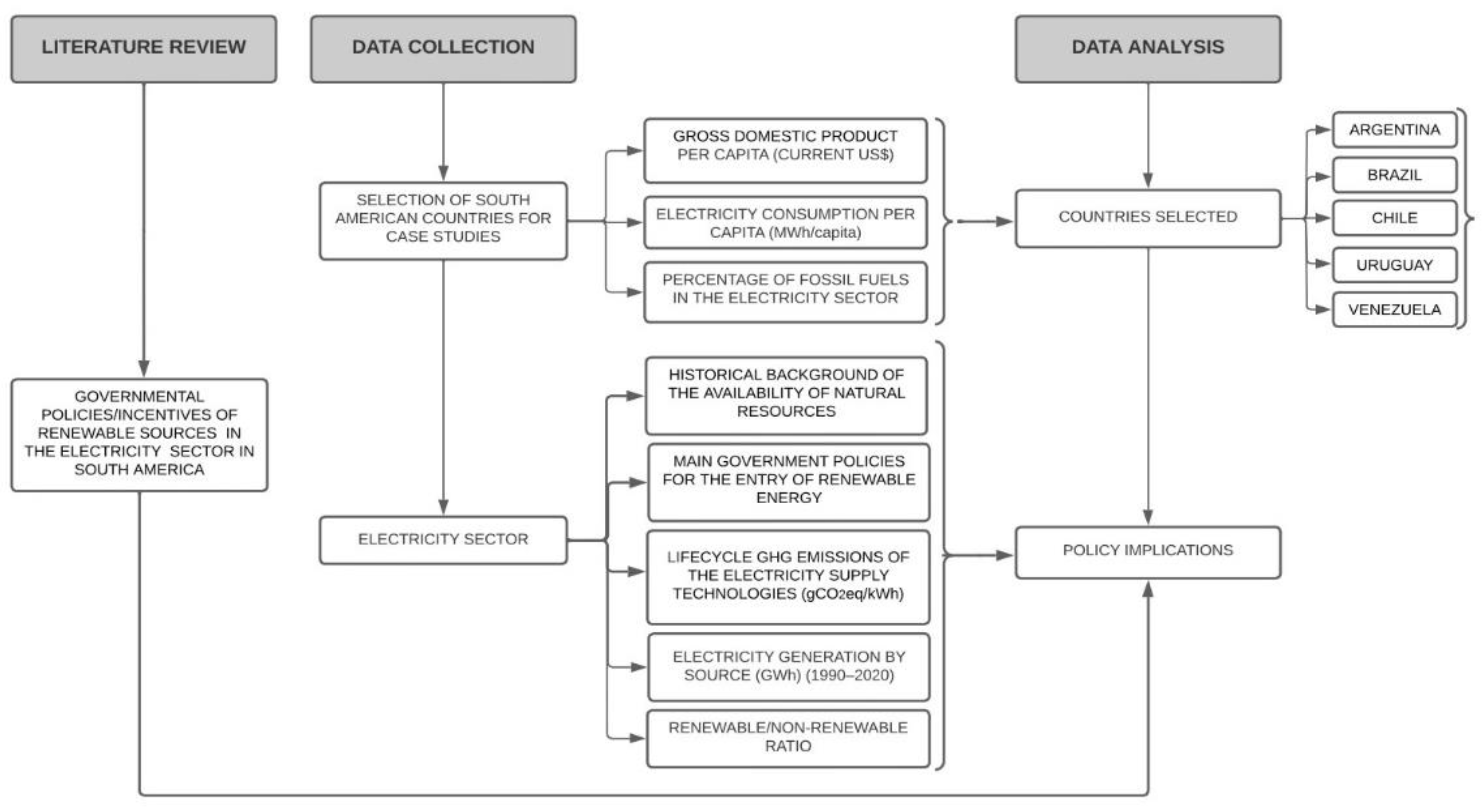
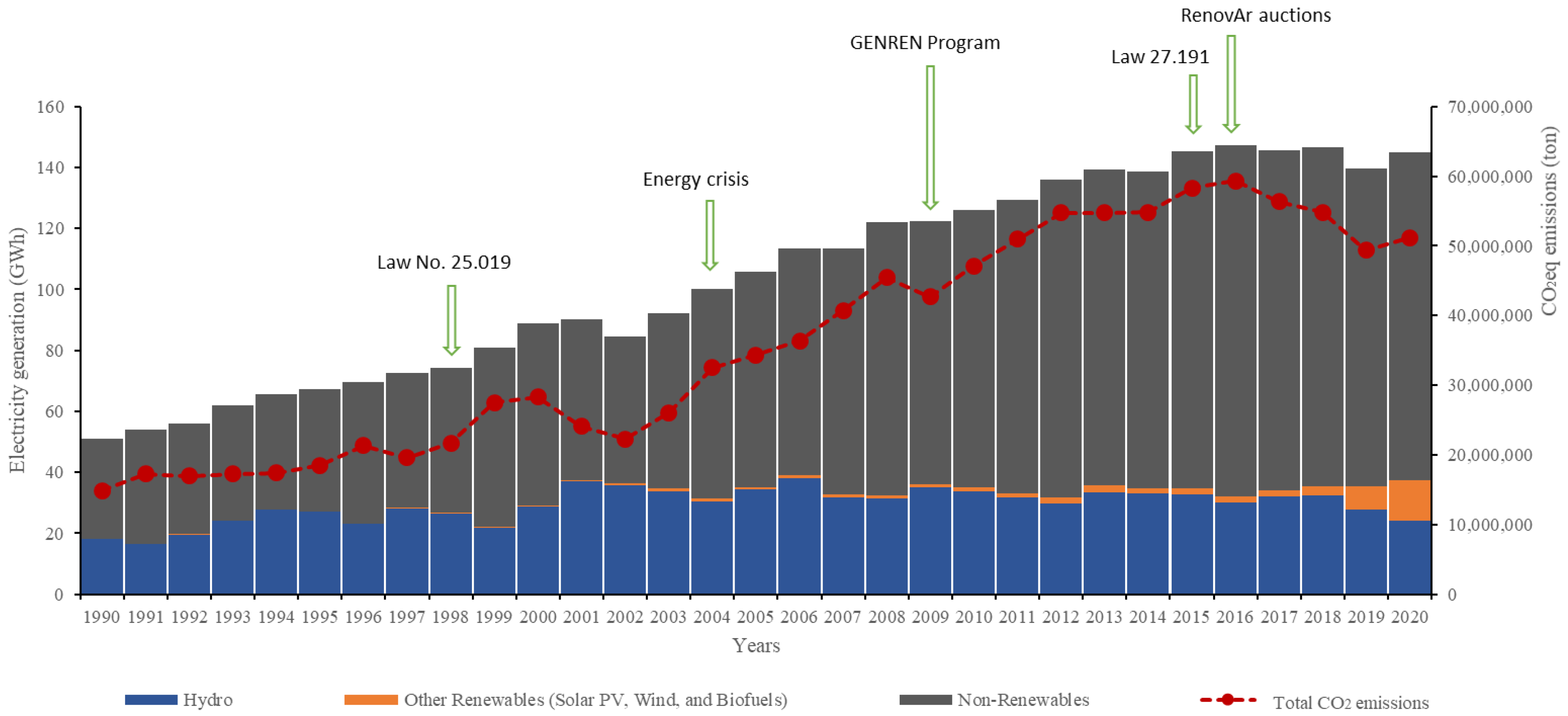
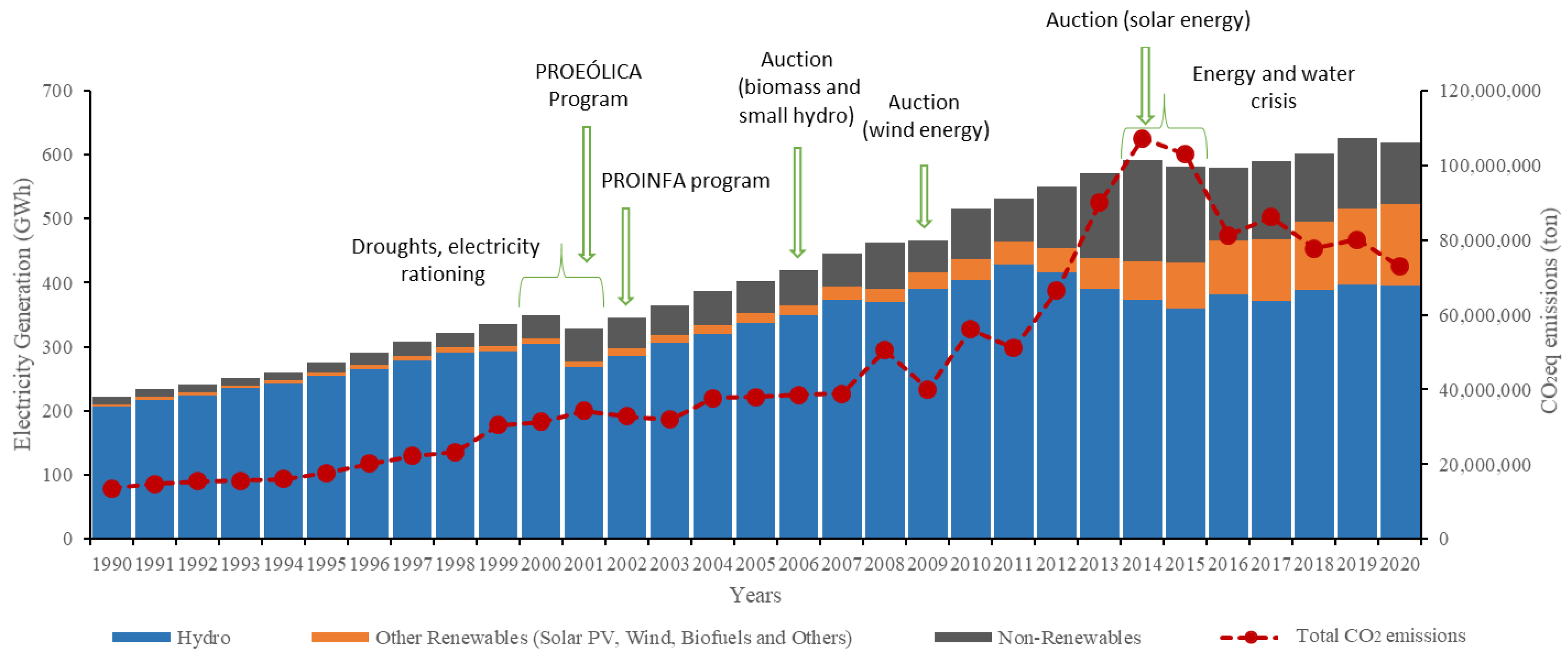
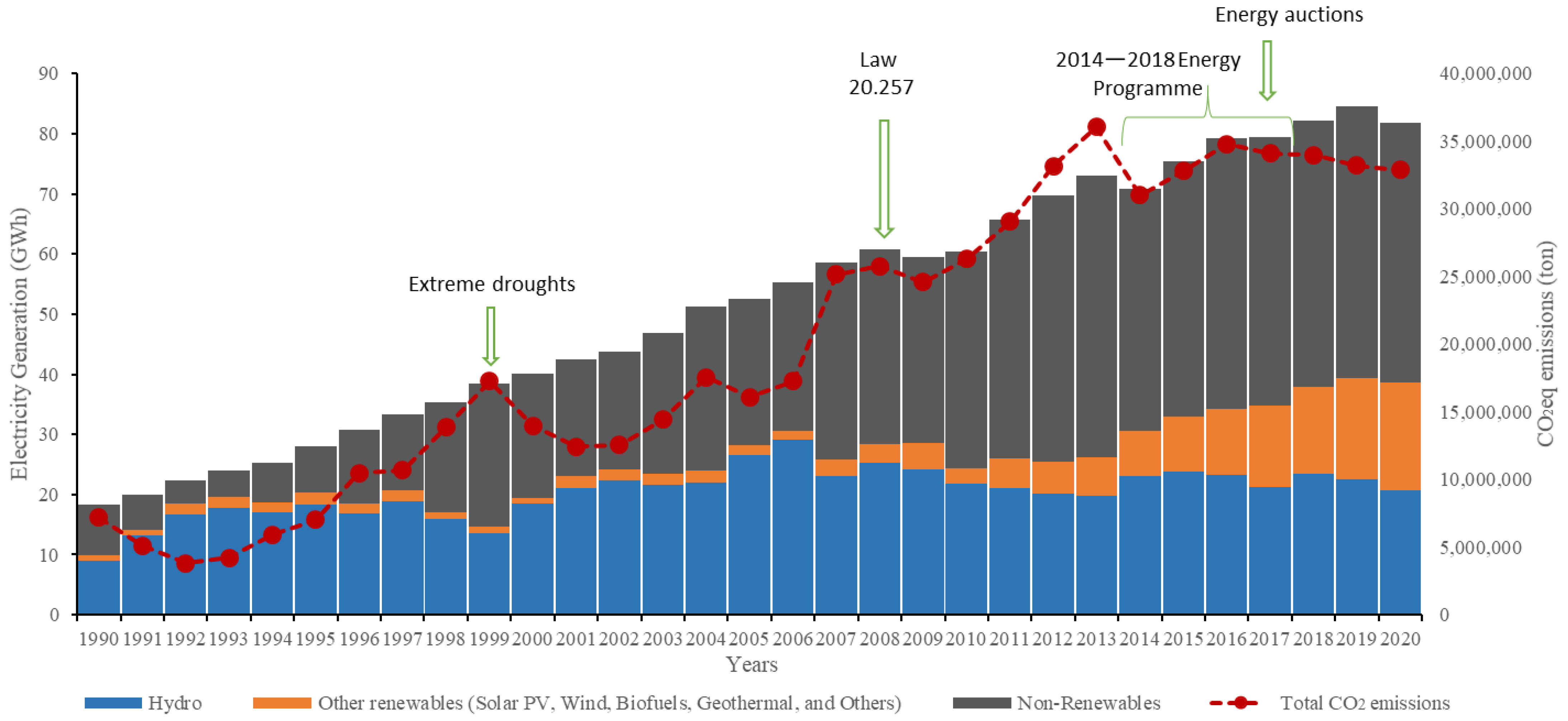
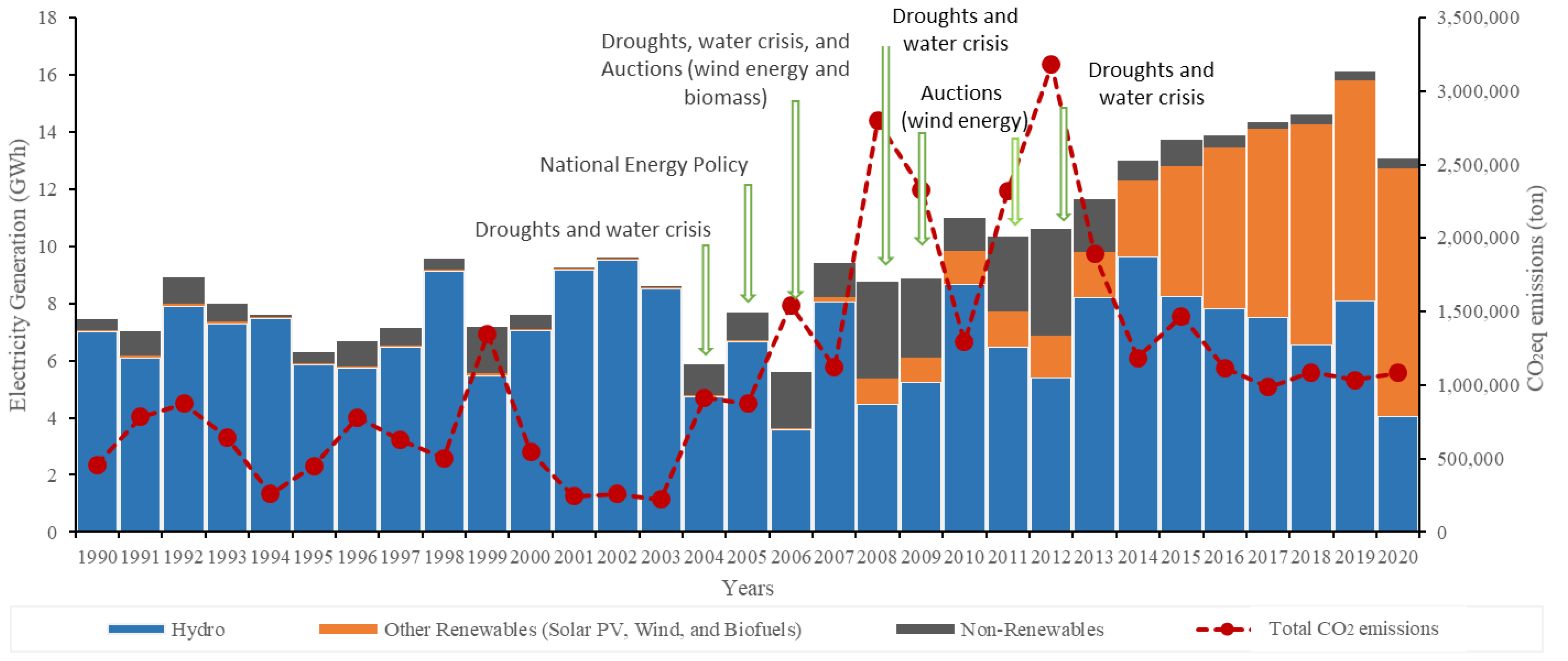
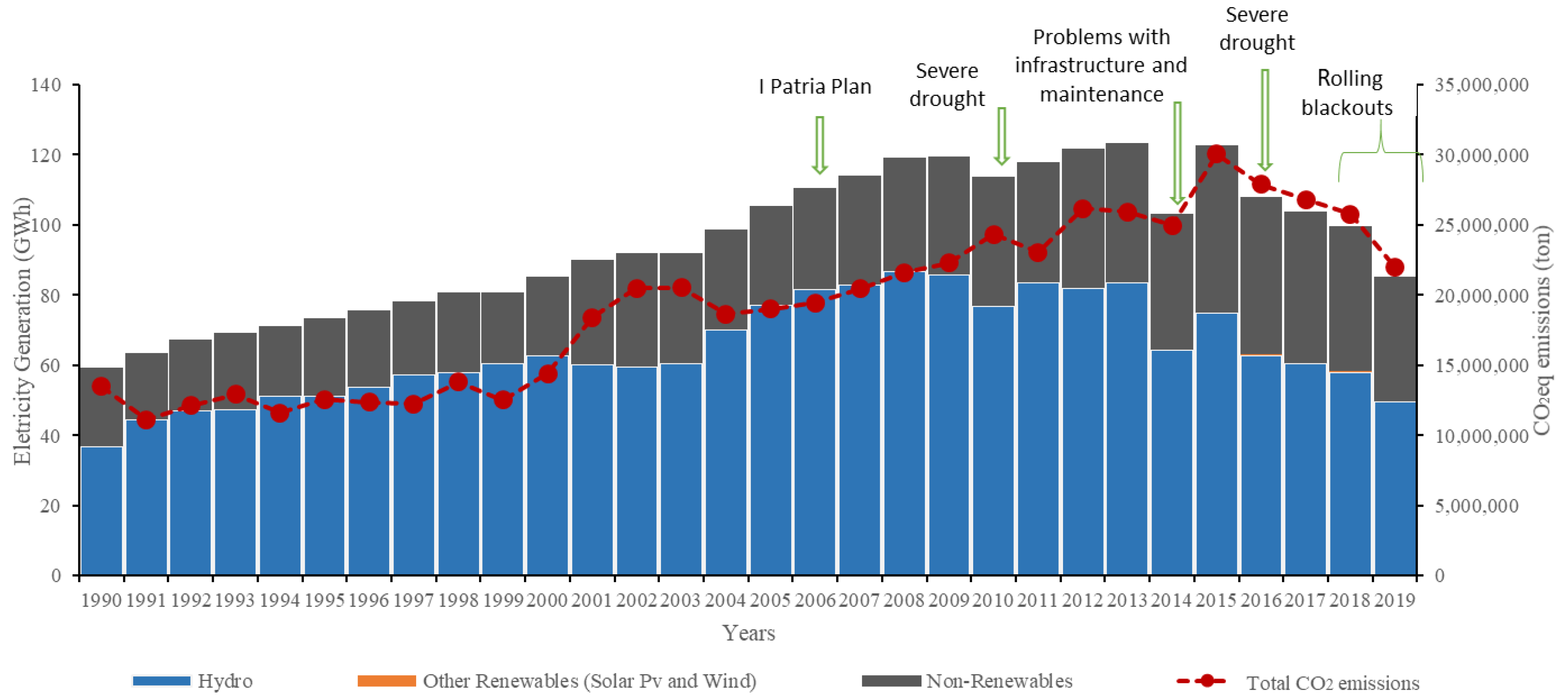
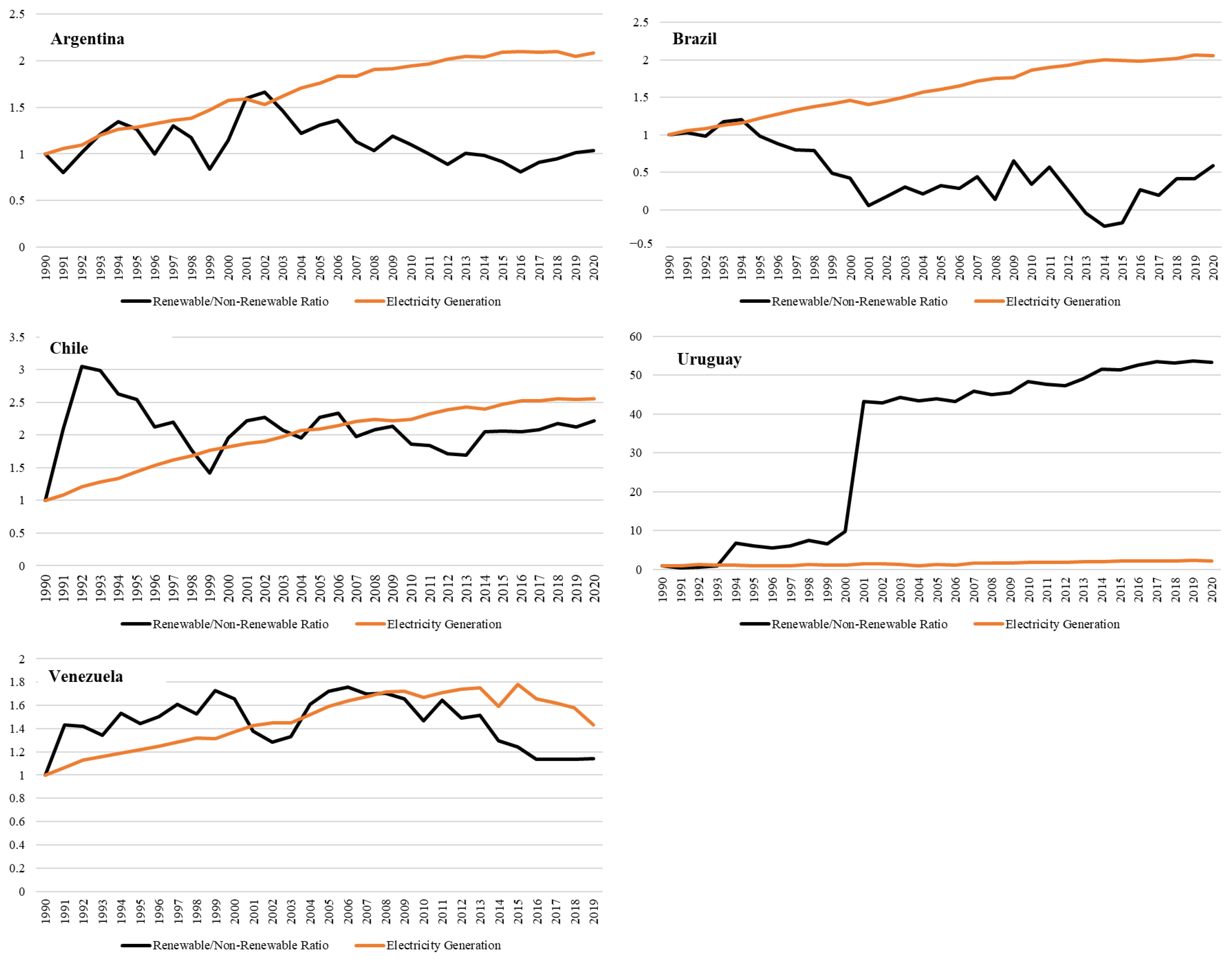
| South American Countries | GDP per Capita (Current USD) | Electricity Consumption per Capita (Megawatt-Hours/Capita) | Percentage of Fossil Fuels in the Electricity Sector | Total |
|---|---|---|---|---|
| Argentina | 2 | 3 | 3 | 8 |
| Bolivia | 0 | 0 | 3 | 3 |
| Brazil | 2 | 2 | 0 | 4 |
| Chile | 3 | 3 | 2 | 8 |
| Colombia | 1 | 0 | 1 | 2 |
| Ecuador | 0 | 0 | 0 | 0 |
| Guyana | 1 | - | - | 1 |
| Paraguay | 0 | 1 | 0 | 1 |
| Peru | 1 | 1 | 1 | 3 |
| Suriname | 2 | - | - | 2 |
| Uruguay | 3 | 3 | 0 | 6 |
| Venezuela | 3 | 2 | 2 | 7 |
| Name | Category | Date | Main Goal |
|---|---|---|---|
| National Regime of Wind and Solar Energy—No. 25.019 | Law | 1998 | To promote wind and solar energy and establish a feed-in tariff of 0.01 USD/kWh for wind [46]. |
| No. 26.190 | Law | 2006 | To promote the production and use of renewable sources of electric energy, mainly wind, solar PV, and geothermal [47]. |
| Renewable Energy Generation Program (GENREN) | Program | 2009 | To deploy 1000 MW of renewable electricity capacity distributed among wind energy, liquid biofuel-fired power generation, solid urban waste, biomass, small hydro, geothermal, solar, and biogas [48]. |
| No. 562 | Decree | 2009 | To ask provinces to adhere to Law 25.019 and develop their province-level incentives [49]. |
| No. 108 | Resolution | 2011 | To enable the execution of supply contracts between the wholesale electricity market and the offers of generation and associated energy availability from renewable sources [50]. |
| No. 27.191 | Law | 2015 | To promote the development of renewable electricity generation, increasing the share of renewables (including hydro smaller than 50 MW) in total power generation to 20% by 2025 [51]. |
| Argentina NDC | International Agreement | 2015/2020 | To promote clean sources of energy such as wind, solar, hydroelectric, and bioenergy, as well as the development of nuclear power and other energy carriers such as hydrogen. In the medium term, natural gas will be used as a transition fuel [52,53]. |
| Argentina Renewable Energy Auctions—RenovAr Program (No. 136/2016) | Resolution/ Auctions | 2016 | To grow renewable sources (wind, solar PV, biogas, biomass, small-hydropower) to 20% of the national energy matrix by 2025 [54]. |
| No. 27.424 | Law | 2017 | To set the policies and establish the legal conditions and contracts for generating renewable electricity [55]. |
| Name | Category | Date | Main Goal |
|---|---|---|---|
| Emergency Wind Energy Program (PROEÓLICA)—No. 24/01 | Resolution | 2001 | To enable the implantation of 1050 MW installed wind capacity by December 2003, integrated into the National Interconnected System [62]. |
| Incentive Program for Alternative Sources of Electric Energy (PROINFA)—Law10.438/02, Law 10.762/03, Law 11.075/04 and Decree 5.05/04 | Law/Decree | 2002–2004 | To stimulate electricity generation by wind, biomass sources (such as sugarcane bagasse and landfill gas) and small hydroelectric plants [63]. It also stipulated that the rules of renewable energy sources would supply 10% of the electricity demand by 2025 [64,65]. |
| Energy Auction from Alternative Sources * | Auctions | 2007 | To promote the insertion of biomass and small hydro [66]. |
| Reserve Energy Auction ** | Auctions | 2009 | To promote wind energy [66]. |
| Reserve and New Energy Auctions ** | Auctions | 2014 | First auction to promote solar energy, in addition to wind and hydroelectric (10,790 MW) [66]. |
| NDC | International Agreement | 2015/2020 | To achieve 10% efficiency gains in the electricity sector by 2030 and raise the electricity sector’s hydropower, wind, biomass, and solar share [67]. |
| No. 10.946 | Decree | 2022 | To allow offshore electricity generation [68]. |
| Name | Category | Date | Main Goals |
|---|---|---|---|
| No. 19.657 | Law | 2000 | To provide a clear regulatory framework for geothermal exploration and development [75]. |
| Non-Conventional Renewable Energy Law (No. 20.257) | Law | 2008 | To generate 10% of its electricity from renewable sources by 2025, such as geothermal, wind, solar, tidal, biomass and small hydroelectric plant [76]. |
| No. 20.698 (20/25) | Law | 2013 | To generate 20% of Chiles’s electricity from renewable sources by 2025, not including hydroelectric plants with more than 20 MW [77]. |
| No. 20.780 | Law | 2014 | To introduce a carbon tax on emissions from power plants [78]. |
| 2014–2018 Energy Program | Program | 2014/2018 | To achieve 45% renewable energy share for new electrical capacity installed between 2014 and 2025 [79]. |
| NDC | International Agreement | 2015/2020 | The decarbonization plan of the electrical matrix by 2040, bringing a reduction of 7.5 MtCO2eq by 2050. In addition, the closure of all coal-fired power generation plants should occur no later than 2040 [80]. |
| Chile energy auctions | Auctions | 2017 | To run auctions for renewable and non-renewable technologies and long-term power-purchase agreements [81]. |
| Name | Category | Date | Main Goals |
|---|---|---|---|
| No. 561/1980 | Decree | 1980 | To plan and accelerate the use of alternative energy sources and reduce energy consumption [85]. |
| No. 16.906 | Law | 1998 | To provide the framework for fiscal incentives to promote renewable energy investments [86]. |
| No. 67/002 | Resolution | 2002 | To determine the exemption of Value Added Tax for wind power equipment [87]. |
| National Energy Policy 2005–2030 | Energy Plan | 2005 | A long-term energy plan with the overall objective to diversify the energy matrix, reduce dependency on fossil fuels, improve energy efficiency, and increase endogenous resources, mostly renewables [88]. |
| No. 77/2006 (amended by the No. 397/007) | Decrees | 2006 | To promote auctions power capacity of 20 MW for wind power, 20 MW for biomass and 20 MW for small hydropower [89]. |
| N0. 354/2009 | Decree | 2009 | To promote renewable energies, provide income tax reductions for renewable electricity generation, renewable energy service providers and equipment manufacturing [90]. |
| No. 18.585 | Law | 2009 | To promote solar thermal energy development through tax incentives [91]. |
| No. 18.597—Efficient Use of Energy | Law | 2009 | To define energy efficiency and the mechanisms for its certification, promotion and financing [92]. |
| No. 403/2009 (continued by N. 159/2011) | Decrees/Auctions | 2009–2011 | To promote auctions of 150 MW of capacity for wind [93]. |
| No. 424/011, No. 158/012 and No. 433/012 | Decrees/Auctions | 2011–2012 | To regulate wind power for self-consumption for industrial consumers [84]. |
| NDC | International Agreement | 2015–2020 | To invest in wind energy and biomass energy generation by 2025. And the Energy Efficiency Plan should begin in 2024 [94]. |
| Name | Category | Date | Main Goals |
|---|---|---|---|
| Gazette 5.568 | Law | 2001 | To authorize independent producers’ power generation [100,101]. |
| Gazette 38.683 | Decree | 2007 | To create the National Renewable Energy Registry that enforced the actions related to solar, hydraulic, wind, biomass, geothermal, tidal and hydrogen energy sources, such as the use and application of projects, equipment, and research [101,102]. |
| I Patria Plan(2007–2013) | Government program and laws | 2007 | To generate alternatives to exploiting non-renewable resources [103]. |
| Development Plan for the National Electric System | National plan | 2013 | To integrate renewable energy in Venezuela’s electric system by including it in both the medium-term (2013–2019) and long-term (2014–2033) [104]. |
| II Patria Plan(2013–2019) | Government program and laws | 2013 | To promote energy-efficient cities through the use of energy-saving technologies, as well as those based on the use of clean energy (wind, gas, among others) and increase the generation of solar energy through the installation of solar panel factories, which primarily serve the energy demand of isolated populations [104]. |
| NDC | International Agreement | 2015/2021 | Progressive reducing GHG emissions by at least 20% for 2030, without any value specified for the electricity sector [105]. |
| III Patria Plan(2019–2025) | Government programs and laws | 2019 | To promote clean energy generation, increase its participation in the national energy matrix, and promote technological sovereignty [106]. |
| National Plan of Alternatives EnergyPNEA (2021–2025) | Bill | 2021 | To add alternative sources to serve the National Electric System [105]. |
| Electricity Consumption | Renewable/Non-Renewable Ratio | ||||
|---|---|---|---|---|---|
| Equation | R² | Equation | R² | Spearman’s Coefficient | |
| Argentina | y = 3562.6x + 47,038 | 0.9743 | y = −0.0119x + 0.6587 | 0.5638 | −0.810887097 |
| Brazil | y = 14,608x + 187,860 | 0.9814 | y = −0.5201x + 17.203 | 0.7577 | −0.73891129 |
| Chile | y = 2297.7x + 15,143 | 0.9947 | y = −0.0743x + 2.5284 | 0.4164 | −0.671572581 |
| Uruguay | y = 257.75x + 5536.2 | 0.6694 | y = −1.2842x + 87.406 | 0.005 | 0.384879032 |
| Venezuela | y = 1819.6x + 66,646 | 0.65 | y = −0.0283x + 2.6491 | 0.2598 | −0.086985539 |
Publisher’s Note: MDPI stays neutral with regard to jurisdictional claims in published maps and institutional affiliations. |
© 2022 by the authors. Licensee MDPI, Basel, Switzerland. This article is an open access article distributed under the terms and conditions of the Creative Commons Attribution (CC BY) license (https://creativecommons.org/licenses/by/4.0/).
Share and Cite
Peyerl, D.; Barbosa, M.O.; Ciotta, M.; Pelissari, M.R.; Moretto, E.M. Linkages between the Promotion of Renewable Energy Policies and Low-Carbon Transition Trends in South America’s Electricity Sector. Energies 2022, 15, 4293. https://doi.org/10.3390/en15124293
Peyerl D, Barbosa MO, Ciotta M, Pelissari MR, Moretto EM. Linkages between the Promotion of Renewable Energy Policies and Low-Carbon Transition Trends in South America’s Electricity Sector. Energies. 2022; 15(12):4293. https://doi.org/10.3390/en15124293
Chicago/Turabian StylePeyerl, Drielli, Mariana Oliveira Barbosa, Mariana Ciotta, Maria Rogieri Pelissari, and Evandro Mateus Moretto. 2022. "Linkages between the Promotion of Renewable Energy Policies and Low-Carbon Transition Trends in South America’s Electricity Sector" Energies 15, no. 12: 4293. https://doi.org/10.3390/en15124293
APA StylePeyerl, D., Barbosa, M. O., Ciotta, M., Pelissari, M. R., & Moretto, E. M. (2022). Linkages between the Promotion of Renewable Energy Policies and Low-Carbon Transition Trends in South America’s Electricity Sector. Energies, 15(12), 4293. https://doi.org/10.3390/en15124293






